Giovanni di Corraduccio, who was probably born in Foligno, appears in documents as:
-
✴"magister Iohannes Coradutii de Fulgineo pictor";
-
✴"magister Iohannes Corradutii alias Mazaforte pictor" ; and
-
✴"magister Iohannes Coradutii Galassi alias Macçaforte pictor de Fulgineo".
The earliest of these documents, which are in the archives of in an Gregorio Maggiore, Spoleto, relate for works for the church in 1404 and 1411 that no longer survive. Neither does a documented work (1417) for Santa Maria degli Angeli, Assisi. Of his four documented works, only fragments of the frescoes (1415) in the Cappella della Santa Croce in the Duomo of Fabriano survive. All of the attributions below are ultimately based on comparison with them.
Andrea di Cagno, who is documented in Foligno from 1408, seems to have belonged to the workshop of Giovanni di Corraduccio.
Giovanni di Corraduccio was last documented in 1437. Three years later, his son Pietro di Giovanni Mazzaforte, who was also a painter, rented a workshop in his own name, which suggests that Giovanni di Corraduccio had died in the interim.
Foligno
Frescoes for the Trinci Family (early 15th century)
The earliest frescoes (ca. 1407) that Ugolino III Trinci commissioned for Palazzo Trinci and the (probably) contemporary frescoes of the upper loggia of the so-called Palazzetto del Podestà have traditionally been attributed to Giovanni di Corraduccio Mazzaforte. He has therefore been assumed also to have painted the very similar frescoes of the Loggia del Paradiso of the Abbazia di Sassovivo, probably at the behest of Giacomo Trinci, a nephew of Ugolino III Trinci, who was abbot at Sassovivo in 1411-39. However, Francesco Federico Mancini (referenced below) has suggested that these fresco cycles might have been the work of Paolo Nocchi.
These three fresco cycles are described in turn:
Seven ages of man (ca. 1407)

The remnants of this cycle of nearly-monochrome frescoes were discovered beneath the later frescoes on the left wall of the corridor on the piano nobile that links Palazzo to the Duomo. Since the corridor was built in ca. 1407 and the later frescoes were executed by Gentile da Fabriano and his workshop in 1411-12, and since the subject of the over-painted frescoes was repeated on the opposite wall in the later frescoes, it is clear that the initial plans were modified in favour of a more ambitious programme at an early stage.
This consideration led Francesco Federico Mancini (referenced below) to suggest that Paolo Nocchi, the only local artist to work under Gentile da Fabriano, might have been commissioned initially in his own right to decorate the corridor and then continued in a subordinate role under Gentile da Fabriano when more ambitious plans were put into effect.
Frescoes in Palazzetto del Podestà (ca. 1407)

The so-called Palazzetto del Podestà, which became a Trinci residence in the 14th century, was linked by an overpass to Palazzo Trinci, probably at about the time that the latter was built. The frescoes of its upper loggia, which were probably all the work of the same artist, seem to have formed part of the original programme devised for the decoration of Palazzo Trinci:
-
✴The (nearly) monochrome frescoes on the interior walls, which were discovered in 1986 (illustrated in the paper by Francesco Federico Mancini referenced below), are very similar to frescoes (ca. 1407) that Ugolino III Trinci commissioned for the corridor that links Palazzo Trinci to the Duomo. Mancini deduces that one fresco probably illustrate the mythical founding of Foligno after the burning of Troy, while the other scenes demonstrate the virtues and legitimacy of the Trinci family.
-
✴The frescoes on the exterior facade, above the windows of the loggia (illustrated above), which represent the Cardinal Virtues, reinforce this theme.
-
✴The device “fa” on the frescoes on the middle register of the facade, which probably represents the motto “fides adiuvat” (faith helps), is also found extensively inside Palazzo Trinci.
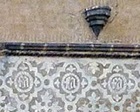
Frescoes of Loggia del Paradiso, Abbazia di Sassovivo (early 15th century)
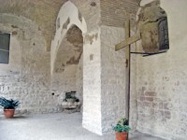
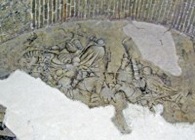
These damaged nearly-monochrome frescoes in the so-called Loggia del Paradiso of the Abbazia di Sassovivo are also very similar to frescoes (ca. 1407) that Ugolino III Trinci commissioned for the corridor that links Palazzo Trinci to the Duomo. They are almost certainly by the same artist, and were probably commissioned by Giacomo Trinci, a nephew of Ugolino III Trinci, who was abbot at Sassovivo in 1411-39.
Tree of Life (15th century)

Madonna and Child (15th century)
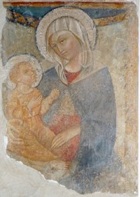
Frescoes (15th century)
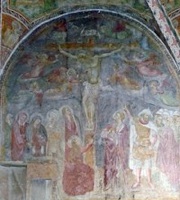
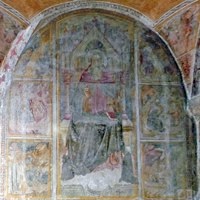
The frescoes in Santa Maria in Campis (in the 2nd chapel on the left), which are attributed to Giovanni di Corraduccio, called Mazzaforte, depict:
-
✴the Crucifixion with the Virgin and her ladies and SS John the Evangelist and Mary Magdalene, on the right wall;
-
✴the Madonna and Child with St Stephen, on the back wall (not illustrated here); and
-
✴St Antony Abbot and scenes from his life, on the left wall.
Frescoes (15th century)
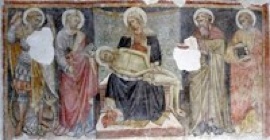
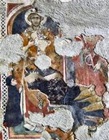
Frescoes in San Domenico that are attributed to Giovanni di Corraduccio Mazzaforte include:
-
✴the Pietà with SS Michael, James, Antony Abbot and Bartholomew [3];
-
✴SS Gregory and Leonard with donor [8a] (which is painted over another fresco [8] of the death of St Peter Martyr (see below); and
-
✴the Mystical Marriage of St Catherine [16], not illustrated here.
Madonna del Latte (early 15th century)
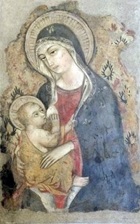
Way to Calvary (15th century)
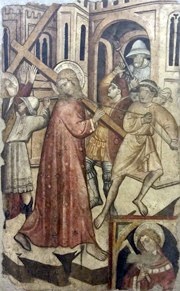
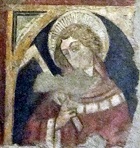
Detail (enlarged)
This fresco, which is attributed to Giovanni di Corraduccio Mazzaforte, is now in the Pinacoteca Civica. The Pinacoteca includes it among those from San Giovanni Decollato (below), but the presence of an image of St Claudius (with a set square) in the lower right-hand corner suggests (at least to me) that it came from San Claudio.
Frescoes from San Giovanni Decollato (ca. 1428)
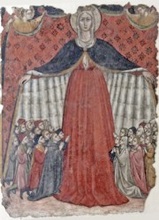


These detached frescoes, which are attributed to Giovanni di Corraduccio Mazzaforte, were detached in 1869 when San Giovanni Decollato was demolished and are now in the Pinacoteca Civica.. They include (from left to right above):
-
✴the Madonna della Misericordia;
-
✴the Crucifixion with the Virgin and SS John the Baptist and Mary Magdalene; and
-
✴a fragment of a the Madonna and Child.
Assisi
Crucifixion with saints (15th century)
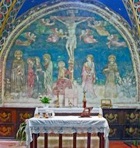
Gualdo Tadino
Frescoed Triptych (1445)
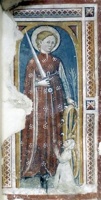
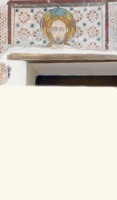
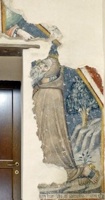
This frescoed triptych on the altar wall of Santa Maria dei Raccomandati, which was rediscovered in the restoration of 2009, is attributed to Giovanni di Corraduccio. It had unfortunately been damaged by the insertion of the door to the sacristy. It depicts the risen Christ, flanked by:
-
✴St Catherine of Alexandria, with the kneeling female donor, who belonged to the confraternity; and
-
✴St Antony Abbot in the desert, meditating on God the Father above.
The inscription at the lower right reads: “[fecit] fieri Francischa de Gabriellis MCCCCXLV”. This lady, who is presumably the figure depicted with St Catherine, was clearly a relative of Berardus de Gabriellis, a man who appears frequently in the records of the confraternity in the period 1440-90.
Montefalco
Frescoes in San Francesco
The frescoes in three chapels in San Francesco (now the Pinacoteca) are attributed to Giovanni di Corraduccio:
Frescoes of the Cappella della Passione (1415-20)
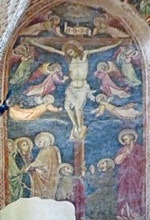
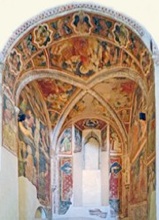
These frescoes of Scenes from the Passion of Christ in the left apsidal chapel were rediscovered under plaster in 1915. They include:
-
✴the Crucifixion with the Virgin andSt John the Evangelist and with SS Mary Magdalene and Francis kneeling at the foot of the cross, on the left wall;
-
✴the descent into Limbo and the Noli me tangere, on the right wall;
-
✴the Annunciation, on the back wall, above a Crucifix that used the iconography of the Volto Santo di Lucca, which was destroyed by the insertion of a window (although the figure of the kneeling donor survives to the left); and
-
✴Evangelists and Apostles, in the vaults.
Frescoes of the Cappella dell’ Annunzione (ca. 1435)
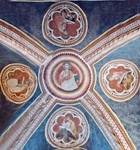
Frescoes of the Cappella di Santa Maria Assunta (early 15th century)
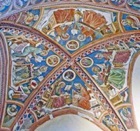
-
✴SS Jerome and Mark;
-
✴SS Ambrose and Matthew;
-
✴SS Augustine and John the Evangelist; and
-
✴SS Gregory and Luke.
Fresco Fragment (1418)
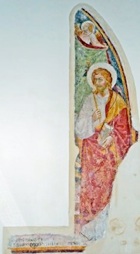
Frescoes (15th century)
These frescoes in Sant’ Agostino, which are attributed to Giovanni di Corraduccio Mazzaforte, depict:
-
✴the Madonna della Misericordia (on the counter-facade, to the right of the portal); and
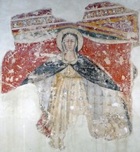
-
✴a fragment of a Nativity (in the nearby niche on the left wall).
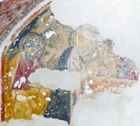
Maestà with saints (15th century)
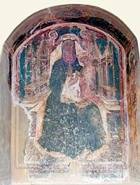
FACTUM FUIT TEMPORE DOMINORUM VIRORUM IOHANNIS SER PETRI CORRADINI GERALDI ... PETRUCIOLI ET PRIORUM TERRE MONTISFAL
Crucifixion (15th century)
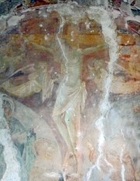
Trevi
Triptych (early 15th century)

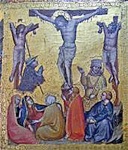
Detail of the Crucifixion
The triptych, which is attributed to Giovanni di Corraduccio Mazzaforte, came from Santa Croce. It comprises numerous scenes from the life of Christ, with the Coronation of the Virgin and the Annunciation in the top register. SS Agnes, Emilianus, Jerome and John the Baptist are on the reverse of the folding wings. An inscription commemorates the donors, Cicco Urighi and Jacobuccio di Mattia.
The Commune blocked the attempted sale of the triptych in 1839, and it was moved to the Pinacoteca in 1867.
Panels from a Polyptych (ca. 1430)
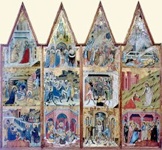

Detail of the Flight into Egypt
These four panels, which are attributed to Giovanni di Corraduccio Mazzaforte, came from San Francesco. They depict scenes from the life of Christ. A number of scenes that must have been included (eg. the Crucifixion) are missing, suggesting that there was originally a fifth, central panel. The surviving panels were moved to the Pinacoteca in 1867.
Read more:
P. Scarpellini, “Giovanni di Corraduccio Mazzaforte”, (1976) Foligno
Two articles that relate to the suggested attribution to Paolo Nocchi rather than Giovanni di Corraduccio Mazzaforte of the original frescoes in the corridor from Palazzo Trinci to the Duomo (and thus those of the Palazzetto del Podestà and of the Loggia del Paradiso of the Abbazia di Sassovivo) are included in:
G. Benazzi and F. Mancini (Eds), “Il Palazzo Trinci di Foligno”, (2001) Perugia:
✴F. Mancini, “La Loggia delle Virtù: Allegoria di un Governo Illuminato”, p 334; and
✴G. Benazzi, “I Cicli Pittorici del Tempo di Ugolino e Corrado Trinci”, pp 470-1.
Return to Art in: Assisi Foligno Gualdo Tadino Montefalco Trevi.



